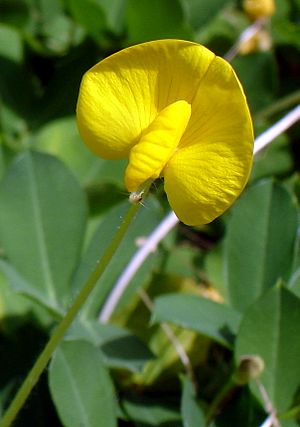Creeping forage peanut facts for kids
Quick facts for kids Creeping forage peanut |
|
|---|---|
 |
|
| Scientific classification | |
| Genus: |
Arachis
|
| Species: |
glabrata
|
Arachis glabrata, also known as creeping forage peanut or rhizoma peanut, is a special plant that comes from parts of Argentina, Brazil, and Paraguay. It's a very useful plant because it provides high-quality food for animals, helps protect the soil, and even looks nice in gardens.
Contents
What is Creeping Forage Peanut?
The creeping forage peanut is a type of plant that grows close to the ground. It gets its name "creeping" because it spreads out using underground stems called rhizomes. Think of rhizomes like secret underground runners that help the plant spread and grow new plants.
Why is it Called "Forage"?
When we say "forage," we mean plants that animals, like cows or horses, eat. The creeping forage peanut is a great source of food for these animals. It's packed with nutrients, which helps animals stay healthy and strong.
A Plant That Lives Long
This plant is also known as a perennial. This means it lives for many years, unlike some plants that only live for one or two seasons. Because it's perennial, farmers don't have to replant it every year, which saves a lot of time and effort.
Where Does Creeping Forage Peanut Grow?
The creeping forage peanut is originally from South America. It thrives in warm places with plenty of sunshine. Over time, people have found it so useful that they've started growing it in other parts of the world too.
Its Natural Home
Its native home includes countries like Argentina, Brazil, and Paraguay. In these places, it grows naturally in fields and open areas. It's well-adapted to the local climate and soil conditions there.
How is Creeping Forage Peanut Used?
This amazing plant has several important uses. It's not just for feeding animals; it also helps the environment and makes places look beautiful.
Food for Animals
One of its main uses is as forage for livestock. Animals like cattle, sheep, and goats love to eat it. It's a very nutritious food source, helping them grow and produce milk or meat.
Protecting the Soil
The creeping forage peanut is also excellent for soil conservation. Its dense network of roots and rhizomes holds the soil together. This prevents soil from being washed away by rain or blown away by wind, which is called erosion. By preventing erosion, it helps keep the land healthy for farming.
A Pretty Plant
Sometimes, this plant is used as an ornamental plant. This means it's grown because it looks attractive. It has pretty yellow flowers that can brighten up gardens and landscapes. People might plant it along roadsides or in parks to add beauty.
Growing Creeping Forage Peanut with Other Plants
Farmers often grow creeping forage peanut alongside other plants. This practice has many benefits for the soil and the animals.
Companion Plants
It's commonly grown with different types of grasses. These include plants like Axonopus fissifolius, Brachiaria decumbens, and Cynodon dactylon. Growing them together can create a diverse and healthy pasture for animals.
Working with Legumes
The creeping forage peanut is a type of legume. Legumes are special because they can take nitrogen from the air and put it into the soil. This acts like a natural fertilizer for other plants. Farmers sometimes grow it with other legumes like Medicago sativa and Trifolium repens to make the soil even richer. This helps all the plants in the field grow better.

